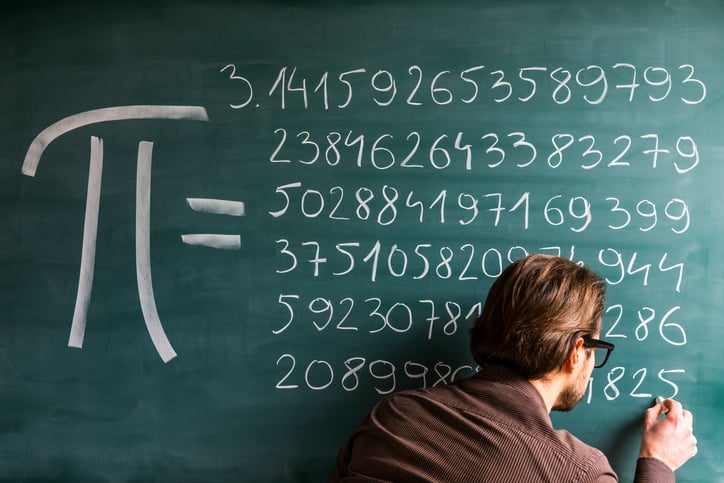If we were to write down the most accurate value of Pi today, we’d have to jot down a number that contains trillions of digits. Although, truthfully, the mathematical constant known as Pi goes on forever. But while accuracy in mathematics is important—so is sanity. For this reason, mostly we refer to the value of Pi, or π, as 3.14159.
In applied mathematics, Pi describes the ratio of a circle’s circumference to its diameter. The origin of Pi goes back thousands of years to some of the world’s most ancient civilizations. Although the values attributed to Pi back then were not exactly the one we use today, it’s remarkable just how close ancient scientists became. The origin of Pi makes for a fascinating story.
The Unbelievable Origin of Pi
The value of Pi has intrigued the world’s mathematically minded for thousands of years. The earliest known reference to Pi comes from ancient civilizations such as the Egyptians and the Babylonians. In ancient times, documents such as the Rhind Mathematical Papyrus found the area of a circular shape in a curious, three-step manner:
- Find the diameter.
- Subtract the circle’s ninth part.
- Square the solution.
Ancient math teachers didn’t name their technique Pi, but essentially Pi was what they used. Their value was higher than the one we use today, but it was close enough, considering the tools they had to work with. Documents such as the Rhind Papyrus also prove that children of ancient civilizations studied applied mathematics in much the same way we do, as it contains 84 different problems—not unlike the Middle Kingdom version of a high school worksheet.
Not surprisingly, the ancient Egyptians were accountants and engineers who used intricate mathematical formulas daily. The original Egyptian mathematical system topped out at the one-million mark, still they could build impossible structures such as stone pyramids, tombs and statues.
The Importance of Pi in Applied Mathematics
The field of applied mathematics is the study of math as it pertains to real-life applications. Instead of learning math for math’s sake, students of applied mathematics learn the many valuable ways that math is used throughout a world of industries that include:
- Business
- Science
- Computers
- Industry
- Engineering
In the twenty-first century, the applications of mathematics are nearly unlimited and affect far-reaching areas of our lives. Contractors use math to build our homes. Aerospace engineers use math to keep us safely in the air when we’re in planes and helicopters. Car manufacturers use math to design and build newer and safer vehicles. And farmers use math to produce crops that keep us fed and healthy.
There are few career limits for graduates of applied mathematics. Indeed, this field could even help you build a stone pyramid of your own if you were so inclined. And it would help you decide how much land you needed to buy to support it, how many people you needed to hire to complete it within a certain time frame, and the overall cost of materials used. There are no limits the uses for applied mathematics in the new century.
And in applied mathematics, Pi plays some big roles. A few of the more exciting applications for Pi in real life include:
- Calculating the speed of a professional baseball pitch.
- Calibrating the speedometer of a vehicle.
- Adjusting the orbits of spacecrafts.
Any time you need to work with circles, Pi becomes a literal part of the equation. If you need to calculate the amount of water needed to fill a round, inflatable pool, for instance, you’ll use Pi. The origin of Pi reaches back so far because it has such practical and diverse applications that affect most areas of life, even today.
Pi as a Mathematical Constant
Mathematical constants have fixed values, and more often than not, they appear again and again across a range of mathematical equations. Pi is one such mathematical constant. Its value will always be 3.14159, and it will always appear in equations where circles are a calculation. Regardless of the size of the circle, Pi will always describe the relationship between its diameter and circumference. Mathematical constants are not calculated by physical measurements, which is why they don’t differ from equation to equation. There are many, many constants that appear repeatedly throughout mathematics, with the value of Pi being one of the better known and more frequently used.
Because of its popularity, Pi has its own national day each year. March 14—the calendar equivalent of 3.14—is also the birthday of Albert Einstein. This makes March 14 doubly notable for mathematicians the world over.
How a B.S. in Applied Mathematics Opens Unlimited Doors
When you pursue a Bachelor of Science in Applied Mathematics and Data Science at Post University, you’ll open doors for yourself within the fields of computers, health, pharmaceuticals, science, and more. With a strong foundation in applied mathematics, you’ll be an in-demand candidate for a host of career paths. Not everyone can do math well, but for those who can, the world is a very big place with amazing potential.
Begin your future today with a Bachelor of Science Degree in Applied Mathematics and Data Science at Post University and experience the difference a knowledge of numbers and their many applications can make in your life.
Thank you for reading! The views and information provided in this post do not reflect Post University programs and/or outcomes directly. If you are interested in learning more about our programs, you can find a complete list of our programs on our website or reach out directly!
Please note jobs and/or career outcomes highlighted in this blog do not reflect jobs or career outcomes expected from any Post program. To learn more about Post’s program and its outcomes, please fill out a form to speak with an admissions advisor.
